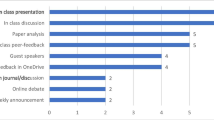Abstract
Recent technological developments have given rise to blended learning classrooms. An inverted (or flipped) classroom is a specific type of blended learning design that uses technology to move lectures outside the classroom and uses learning activities to move practice with concepts inside the classroom. This article compares the learning environments of an inverted introductory statistics class with a traditional introductory statistics class at the same university. This mixed-methods research study used the College and University Classroom Environment Inventory (CUCEI), field notes, interviews and focus groups to investigate the learning environments of these two classrooms. Students in the inverted classroom were less satisfied with how the classroom structure oriented them to the learning tasks in the course, but they became more open to cooperative learning and innovative teaching methods. These findings are discussed in terms of how they contribute to the stability and connectedness of classroom learning communities.
Similar content being viewed by others
References
Albert, D., & Schrepp, M. (1999). Structure and design of an intelligent tutorial system based on skill assignments. In J. Lukas (Ed.), Knowledge spaces: Theories, empirical research and applications (pp. 179–196). Mahwah, NJ: Lawrence Erlbaum.
Baker, J. W. (2000, April). The “classroom flip”: Using web course management tools to become a guide by the side. Paper presented at the 11th international conference on college teaching and learning, Jacksonville, FL.
Bluic, A.-M., Goodyear, P., & Ellis, R. A. (2007). Research focus and methodological choices in studies into students’ experiences of blended learning in higher education. Internet and Higher Education, 10, 231–244.
Buerck, J. P., Malmstrom, T., & Peppers, E. (2003). Learning environments and learning styles: Non-traditional student enrollment and success in an internet-based versus a lecture-based computer science course. Learning Environments Research, 6, 137–155.
Chandra, V., & Fisher, D. L. (2009). Students’ perceptions of a blended web-based learning environment. Learning Environments Research, 12, 31–44.
Charmaz, K. (2000). Grounded theory: Objectivist and constructivist methods. In N. K. Denzin & Y. S. Lincoln (Eds.), Handbook of qualitative research (2nd ed.). Thousand Oaks, CA: Sage.
Collins, B., de Boer, W., & van der Veen, J. (2001). Building on learner contributions: A web-supported pedagogic strategy. Educational Media International, 38(4), 229–240.
Doignon, J. P., & Falmagne, J. C. (1999). Knowledge spaces. Berlin: Springer.
Donnelly, R. (2010). Harmonizing technology with interaction in blended problem-based learning. Computers & Education, 54, 350–359.
Elen, J., & Clarebout, G. (2001). An invasion in the classroom: Influence of an ill-structured innovation on instructional and epistemological beliefs. Learning Environments Research, 4, 87–105.
Falmagne, J. C. (1993). Stochastic learning paths in a knowledge structure. Journal of Mathematical Psychology, 37, 489–512.
Falmagne, J. C., Cosyn, E., Doignon, J. P., & Thiery, N. (2006). The assessment of knowledge, in theory and in practice. In R. Missaoui & J. Schmid (Eds.), Formal concept analysis (pp. 61–79). Berlin: Springer.
Fraser, B. J. (1998). Classroom environment instruments: Development, validity and applications. Learning Environments Research, 1, 7–34.
Fraser, B. J., Treagust, D. F., & Dennis, N. C. (1986). Development of an instrument for assessing classroom psychosocial environment at universities and colleges. Studies in Higher Education, 11(1), 43–54.
Frederickson, N., Reed, P., & Clifford, V. (2005). Evaluating web-supported learning versus lecture-based teaching: Quantitative and qualitative perspectives. Higher Education, 50, 645–664.
Gannod, G. C., Burge, J. E., & Helmick, M. T. (2008). Using the inverted classroom to teach software engineering. Proceedings of the 30th international conference on software engineering, Leipzig, Germany.
Garrison, D. R., & Kanuka, H. (2004). Blended learning: Uncovering its transformative potential in higher education. Internet and Higher Education, 7(2), 95–105.
Ginns, P., & Ellis, R. (2007). Quality in blended learning: Exploring the relationships between on-line and face-to-face teaching and learning. Internet and Higher Education, 10(1), 53–64.
Lage, M. J., Platt, G. J., & Treglia, M. (2000). Inverting the classroom: A gateway to creating an inclusive learning environment. The Journal of Economic Education, 31(1), 30–43.
Lukas, J., & Albert, D. (1999). Knowledge structures: What they are and how they can be used in cognitive psychology, test theory, and the design of learning environments. In J. Lukas (Ed.), Knowledge spaces: Theories, empirical research, and applications (pp. 3–12). Mahwah, NJ: Lawrence Erlbaum.
Marshall, C., & Rossman, G. B. (2011). Designing qualitative research (5th ed.). Thousand Oaks, CA: Sage.
Moos, R. H. (1974). The social climate scales: An overview. Palo Alto: Consulting Psychologists Press.
Moos, R. H. (1979). Evaluating educational environments. San Francisco: Jossey-Bass Publishers.
Moss, R. H. (2003). Social contexts: Transcending their power and their fragility. American Journal of Community Psychology, 31(1/2), 1–13.
Nijhuis, J. F., Segers, M. S., & Gijselaers, W. H. (2005). Influence of redesigning a learning environment on student perceptions and learning strategies. Learning Environments Research, 8, 67–93.
Patton, M. Q. (2002). Qualitative evaluation and research methods (3rd ed.). Newbury Park, CA: Sage.
Pelto, P. J., & Pelto, G. H. (1978). Anthropological research: The structure of inquiry (2nd ed.). Cambridge: Cambridge University Press.
Seidman, I. (2006). Interviewing as qualitative research: A guide for researchers in education and the social sciences (3rd ed.). New York: Teachers College Press.
So, H.-J., & Brush, T. A. (2008). Student perceptions of collaborative learning, social presence and satisfaction in a blended learning environment: Relationships and critical factors. Computers & Education, 51, 318–336.
Strauss, A., & Corbin, J. (2008). Basics of qualitative research: Techniques and procedures for developing grounded theory (3rd ed.). Thousand Oaks: Sage.
Strayer, J. F. (2009). Inverting the classroom: A study of the learning environment when an intelligent tutoring system is used to help students learn. Saarbrücken: VDM Verlag.
Weinstein, M. (2004). Randomized design and the myth of certain knowledge: Guinea pig narratives and cultural critique. Qualitative Inquiry, 10(2), 246–260.
Wolcott, H. F. (2005). The art of fieldwork (2nd ed.). Walnut Creek, CA: Alta Mira Press.
Author information
Authors and Affiliations
Corresponding author
Rights and permissions
About this article
Cite this article
Strayer, J.F. How learning in an inverted classroom influences cooperation, innovation and task orientation. Learning Environ Res 15, 171–193 (2012). https://doi.org/10.1007/s10984-012-9108-4
Received:
Accepted:
Published:
Issue Date:
DOI: https://doi.org/10.1007/s10984-012-9108-4




